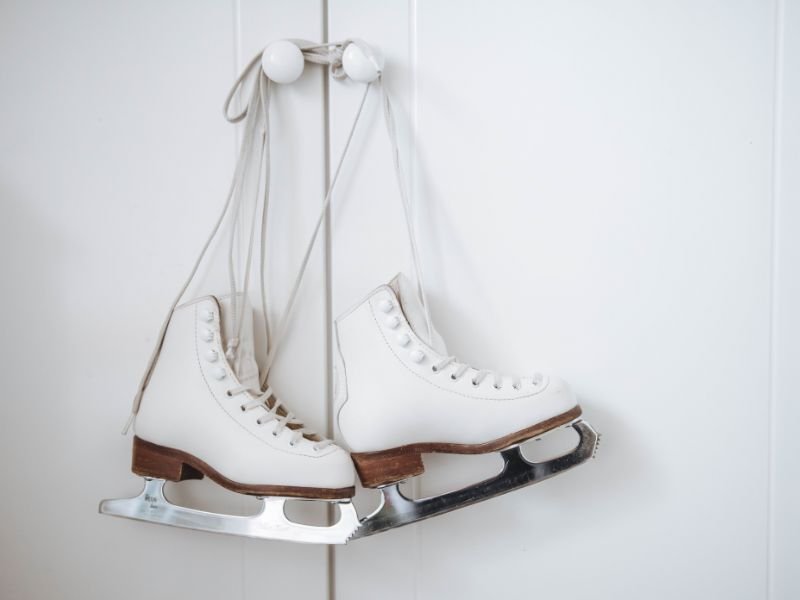Different Types of Ice Skates
Ice skates come in various types such as figure skates, hockey skates, and speed skates, each designed for specific purposes and features. Ice skating is a popular sport and recreational activity enjoyed by people of all ages around the world.
Different types of ice skates are used for specific disciplines and activities on the ice, providing comfort, performance, and safety. Whether it’s for figure skating, ice hockey, or speed skating, choosing the right type of ice skates can greatly enhance your experience and skill level on the ice.
Understanding the different types of ice skates available can help you make an informed decision when purchasing or renting a pair for your specific needs. We will explore the various types of ice skates and their unique features.
Figure Skates
Figure skates are designed for different types of ice skating activities, including figure skating, ice dancing, and synchronized skating. With their sharp blades and sturdy construction, figure skates provide the necessary support and precision for performing intricate spins, jumps, and turns on the ice.
Different Types Of Ice Skates:
If you’re a fan of figure skating, then you know that the right pair of figure skates can make all the difference in your performance on the ice. Figure skates are specifically designed to support the intricate movements and jumps performed by figure skaters, and they come with their own unique features and benefits.
In this section, we’ll explore the different components of figure skates, the features and benefits they offer, and how to choose the perfect pair for your needs.
Features And Benefits Of Figure Skates:
Figure skates are crafted with precision and care, ensuring that they provide the necessary support and flexibility for figure skaters to execute their moves flawlessly. Here are some key features and benefits of figure skates to consider:
- Stiff Boot: Figure skates are equipped with a stiff boot, which helps provide stability and control to skaters during intricate movements and jumps.
- Supportive Ankle Padding: These skates come with ample ankle padding to protect and support the skater’s ankles, reducing the risk of injuries.
- Toe Picks: Figure skates have toe picks at the front of the blade, which allow skaters to execute jumps and spins with ease.
- High-Quality Blade: The blade of figure skates is made of high-quality steel that offers excellent durability and superior performance on the ice.
- Customizable Fit: Many figure skates come with heat-moldable boots, allowing skaters to customize the fit for maximum comfort and performance.
Components Of Figure Skates:
To understand figure skates better, let’s take a closer look at their different components:
- Boot: The boot of figure skates is made of synthetic or leather material, providing the necessary support and structure for the skater’s foot and ankle.
- Blade Holder: The blade holder, also known as the plate, is responsible for securing the blade to the boot.
- Blade: The blade is the most crucial component of figure skates. It is typically made of high-quality steel and has a curved design that enables skaters to perform complex maneuvers on the ice.
- Toe Picks: The toe picks are small, jagged teeth located at the front of the blade. Skaters use these to grip the ice and execute jumps and spins.
How To Choose The Right Pair Of Figure Skates:
When it comes to selecting figure skates, it’s vital to find the perfect fit for your comfort and performance. Consider the following factors when choosing a pair:
- Skill Level: Determine your skill level to ensure you choose skates that accommodate your abilities and skating style.
- Boot Material: Decide between synthetic and leather boots based on your preference and budget. Synthetic boots are less expensive, while leather boots provide better durability.
- Proper Fit: Proper fit is crucial for figure skates. Ensure that the skates provide adequate ankle support without causing discomfort.
- Budget: Set a budget and look for a pair of figure skates that offer the best combination of features and affordability within your budget range.
By understanding the features, components, and considerations for selecting figure skates, you’ll be able to make an informed decision and find the perfect pair for your figure skating adventures on the ice. So lace up those skates and let your passion and talent shine!
Hockey Skates
Explore the world of ice hockey with a wide range of hockey skates designed for different styles and skill levels. From beginner to professional, discover the perfect pair to enhance your performance on the ice.
Different Types Of Ice Skates:
Hockey is an exhilarating sport that requires specific equipment to ensure optimal performance on the ice. One of the most crucial pieces of gear for any hockey player is the pair of hockey skates. Designed with features specific to the demands of the game, hockey skates are essential for speed, agility, and control.
In this section, we will explore the features and benefits of hockey skates, delve into their various components, and provide useful tips on how to select the right pair for your needs.
Features And Benefits Of Hockey Skates
The design of hockey skates incorporates several essential features that contribute to a player’s performance. Here are the key characteristics that set hockey skates apart:
- Blade: Hockey skates have a unique blade design that is shorter and flatter compared to figure skates. This allows for greater maneuverability and quick turns on the ice.
- Holder and Runner: The holder is the component that holds the blade in place, while the runner refers to the hollowed-out section of the blade that makes contact with the ice. This combination provides stability, grip, and control to the player.
- Boot: Hockey skates are built with a stiff and durable boot to provide necessary support and protection to the player’s foot. The added rigidity helps in transferring power efficiently from the skater to the ice.
- Ankle Padding: Hockey skates feature generous padding around the ankle area to offer comfort, support, and protection against potential injuries during fast-paced gameplay.
- Laces: Traditional laces are commonly used in hockey skates, allowing players to customize the tightness and fit according to their preference. Properly laced skates provide stability and prevent foot movement inside the boot.
Components Of Hockey Skates
Understanding the different components of hockey skates is important for players looking to make informed purchasing decisions or perform maintenance. Here are the main components that make up a pair of hockey skates:
- Boot: The boot is the main part of the skate that covers the foot and ankle. It is typically made of synthetic materials or a combination of leather and synthetic materials to provide durability and support.
- Blade: The blade is the bottom part of the skate that makes contact with the ice. It consists of a holder that attaches the blade to the boot and a runner, which is the actual metal piece that glides on the ice.
- Laces: Laces secure the boot tightly around the foot and ankle, ensuring a snug fit for optimal control and stability.
- Tongue: The tongue is the padded section that sits between the laces and the player’s shin. It helps distribute the pressure from the laces and provides additional protection.
- Liner: The liner is the inner layer of the skate that comes in contact with the player’s foot. It offers comfort, moisture-wicking properties, and thermal insulation.
How To Choose The Right Pair Of Hockey Skates
Selecting the right pair of hockey skates is crucial for both performance and comfort on the ice. Here are a few factors to consider when choosing your hockey skates:
- Fit: Finding the right fit is essential. Ideally, hockey skates should fit snugly without causing excessive pain or discomfort. Always try skates on before purchasing and ensure that there is no unnecessary movement inside the boot.
- Level of Play: The level at which you play will impact the type of hockey skates you need. Beginner skates are designed for entry-level players, while advanced skates offer more features and higher performance for experienced players.
- Budget: Determine a suitable budget range for your hockey skates. Remember that investing in a quality pair can provide better performance and durability in the long run.
- Brand and Reputation: Consider reputable brands known for producing high-quality hockey skates. Research reviews and seek recommendations to ensure you make an informed decision.
By understanding the features and benefits, components, and factors to consider when choosing hockey skates, you can be better equipped to make a wise purchasing decision. Ensure a proper fit, and remember to maintain and care for your skates to keep them in optimal condition.
Lace up, hit the ice, and elevate your hockey game with the perfect pair of skates!
Speed Skates
Speed skates are a type of ice skate designed for high-performance speed skating, with a focus on optimizing speed and control on the ice surface. With their sleek and lightweight design, speed skates allow skaters to reach incredible speeds while maintaining stability and agility.
Speed skating is an exhilarating sport that requires precision, technique, and of course, the right equipment. When it comes to ice skates, there are different types specifically designed for various skating disciplines. In this blog post, we will delve into the world of speed skates and explore their features, components, and how to choose the perfect pair for your needs.
Features And Benefits Of
Speed skates are engineered to maximize performance and efficiency on the ice. Here are some key features and benefits of speed skates:
- Long Blades: Speed skates are equipped with long blades that extend beyond the heel, allowing for a longer stride and faster speeds.
- Low Boot: The boot of speed skates is low-cut, providing the skater with a wider range of motion and more ankle flexibility.
- Carbon Fiber Construction: Many modern speed skates utilize carbon fiber materials in their construction, making them lightweight and responsive.
- Blade Alignment: Speed skates prioritize blade alignment, ensuring optimal power transfer from the skater’s body to the ice.
- Minimal Padding: Unlike other types of ice skates, speed skates have minimal padding to reduce weight and improve control.
- Increased Ground Contact: The blades of speed skates have a larger surface area in contact with the ice, enhancing stability and control.
Components Of Speed Skates
To better understand speed skates, let’s take a closer look at their main components:
- Boot: The boot of a speed skate is designed to provide optimal support and stability while allowing for efficient energy transfer from the skater’s leg to the blade.
- Frame: Also known as the chassis, the frame is the metal base that connects the boot and the blade. It plays a crucial role in maintaining stability and transferring power.
- Blades: Speed skate blades are long, straight, and significantly thinner than those of other ice skates. They are usually made of steel and require regular sharpening for optimal performance.
- Laces: Laces are used to secure the boot tightly around the skater’s foot, providing a customized fit and ensuring control and stability.
How To Choose The Right Pair Of Speed Skates
Choosing the right pair of speed skates is essential for maximizing your performance and comfort on the ice. Consider the following factors when selecting your speed skates:
- Boot Fit: Speed skates should fit snugly without being too tight. Look for a boot that provides ample support around the ankle and arch of your foot.
- Blade Length: The length of the blade should be determined by your level of expertise and the specific type of speed skating you intend to pursue. Consult with a professional or an experienced skater for guidance.
- Blade Stiffness: Different skaters have different preferences when it comes to blade stiffness. Stiffer blades offer better energy transfer, but they may also require more strength and control.
- Price Range: Speed skates are available in a range of prices. Determine your budget and invest in a pair that offers the best balance of quality and affordability for your needs.
By understanding the features, components, and considerations involved in choosing speed skates, you are well on your way to embracing the speed skating world with open arms. Lace up your skates, hit the ice, and let the adrenaline flow as you glide effortlessly towards the finish line.

Credit: skatingmagic.com
Frequently Asked Questions Of Different Types Of Ice Skates
What Are The Different Types Of Ice Skates?
Ice skates come in various types including figure skates, hockey skates, speed skates, and recreational skates. Each type is designed with specific features to cater to different skating disciplines and preferences.
What Are Figure Skates Used For?
Figure skates are primarily used for figure skating, which involves spins, jumps, and intricate footwork on ice. These skates have a longer blade and a toe pick at the front to facilitate jumps and precise movements required in figure skating routines.
What Are Hockey Skates Designed For?
Hockey skates are specifically designed for ice hockey. With a shorter and more rounded blade, as well as a flexible boot, hockey skates prioritize speed, agility, and quick turns on the ice, ensuring optimal performance during hockey games.
Are Speed Skates Different From Other Types Of Ice Skates?
Yes, speed skates are different from other ice skates. They are designed for competitive speed skating and have a longer and straighter blade. Speed skates prioritize maximum glide and speed, making them ideal for racing on ice.
Conclusion
Understanding the different types of ice skates is essential for any avid skater. Whether you prefer figure skating, speed skating, or ice hockey, choosing the right type of skate will greatly enhance your performance and enjoyment on the ice. Each type of skate is designed with specific features and characteristics to suit different styles of skating.
For figure skaters, the focus is on grace and precision, while speed skaters require streamlined boots for maximum speed. On the other hand, ice hockey skates are built for agility and durability. It’s important to consider your skill level, comfort, and the specific requirements of your chosen skating discipline when selecting the appropriate ice skates.
By investing in the right pair of skates, you can improve your skills, avoid potential injuries, and thoroughly enjoy the exhilarating experience of gliding across the ice.





